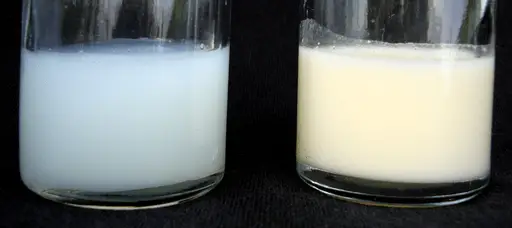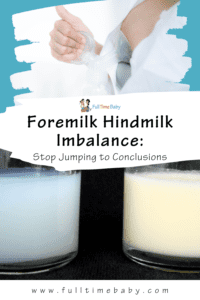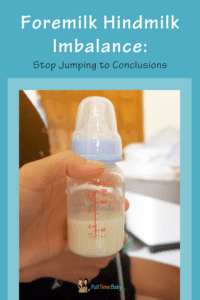Breastfeeding seems painful in the early stages, not only because of the time required but because of soreness or cracked skin. And it seems like your baby just won't..stop..crying. In the search for the cause, moms often stumble upon the Foremilk vs Hindmilk debate or milk supply issues. Let me take you through the premise of the debate.
What Are Foremilk and Hindmilk
Foremilk is the milk produced immediately after let-down at the beginning of the feeding. It tends to be more watery, pale/white in color lower in fat content, higher in lactose, and greater in volume.
Hindmilk refers to milk from the end of the feeding, and conversely is creamier and more yellow in color, with higher fat content and less volume.
There Are Not 2 Types of Milk
Your body makes one kind of milk, but the composition of the milk depends on how empty the breast is or how long it's been stored. Because the fat content of your milk changes gradually, there's no magical shift when foremilk changes to hindmilk. It's a gradual change.
But How Long Should My Baby Feed to Get Hindmilk?
This is one of those areas where you will not get consensus, but for the sake of studies, perhaps some lines in the sand have to be drawn. In a recent study on hindmilk used for low-birth weight infants, foremilk was defined as milk collected for 2-3 mins after letdown, with the remaining "hindmilk" collected from emptying.
When you are feeding a baby you should watch your baby and not the clock. The best advice is to empty each breast as fully as possible, which will also help to signal more milk production.
However at the end of the day, what determines weight gain is the total volume of milk, regardless of their breastfeeding pattern.
Composition of Foremilk and Hindmilk
In a study on nutrient and energy contents of milk during the first 6 months of lactation, including mothers of preterm infants, Protein, lactose and fat contents were measured and energy density estimated.
Lactose content showed no significant changes between the groups or in the course of lactation. The fat content was highest in hindmilk, at approximately two- to threefold that of foremilk. Hindmilk included 25–35 kcal/100 ml more energy on average than foremilk.
The content of your milk also changes constantly depending on the time of day, age of your baby, the mother's body, and time lapsed between feeds. For example if the next feed less than 2 hours away, the fat content may be higher. If your baby is feeding at shorter intervals,
Foremilk vs Hindmilk Imbalance
There are theories (or perhaps myths) about oversupply causing babies to fill up on lactose heavy foremilk, causing fussiness. This is because according to La Leche League "high volume of lactose can overwhelm a baby's digestive system".
Signs:
- Gassiness
- Discomfort
- Green, watery, foamy stools
Commonly Suggested Solutions
- Block feeding - Offering one breast for several feedings in a row
- Empty breast during feedings - The higher fat content in hindmilk helps to balance the excess lactose
What You Should Actually Do
We've become a nation of fixers, thinking that if there's something amiss we can just google to find the solution. As mothers we often turn the problem on ourselves, as if we are the root of every issue.
Babies digestive systems are still developing, and gassiness is an unavoidable part of growing up. Have you ever heard of a baby that has not suffered from gassiness? So moms, Do not change your feeding patterns because of the internet. Instead:
- Watch your baby's weight gain
- Watch your baby's milk intake - if you are exclusively breastfeeding
- Treat the symptoms - Gas drops, keeping your baby on an incline are effective ways to treat gassiness and discomfort. Rather than trying to come up with a different problem, that is rather difficult to prove, trust the natural cycle of breastfeeding
- Get Professional Help - Ask for opinions from lactation consultants who have seen more cases. They will be able to judge the severity of the situation and whether you need intervention
Conclusion
Being a new mother is tough. It's a sleep deprived, 24/7 job where it may seem like you're never getting it right. But you will reach a time when you will laugh about ever looking into the foremilk vs hindmilk debate, I promise.
What was your journey on the foremilk vs hindmilk debate?
References
Saarela, T., Kokkonen, J. and Koivisto, M. (2005), Macronutrient and energy contents of human milk fractions during the first six months of lactation. Acta Pædiatrica, 94: 1176–1181. doi:10.1111/j.1651-2227.2005.tb02070.x
Eidelman Arthur I.. Breastfeeding Medicine. July 2017, ahead of print. https://doi.org/10.1089/bfm.2017.29050.aie
Rings, E. et al. Lactose intolerance and lactase deficiency in children. Curr Op Ped 1994;6: 562-67.



